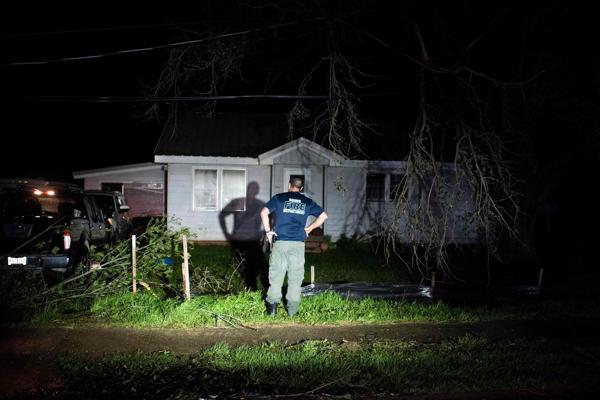Ida downs New Orleans power on deadly path through Louisiana
NEW ORLEANS-The Associated Press


Hurricane Ida knocked out power to all of New Orleans and inundated coastal Louisiana communities on a deadly path through the Gulf Coast that was still unfolding and promised more destruction.
Forecasters warned of damaging winds, heavy rainfall that could cause flash floods and life-threatening storm surge as Ida continued its rampage on Aug. 30 through southeastern Louisiana and then moved into Mississippi. It made landfall on the same day 16 years earlier that Hurricane Katrina ravaged Louisiana and Mississippi, and its 150-mph (230 kph) winds tied it for the fifth-strongest hurricane to ever hit the mainland.
Ida was already blamed for at least one death in Louisiana. Deputies with the Ascension Parish Sheriff’s Office responded to a report of someone injured by a fallen tree at a home in Prairieville outside Baton Rouge and confirmed the death, the office said on Aug. 29 on Facebook. The victim was not identified.
The power outage in New Orleans, meanwhile, heightened the city’s vulnerability to flooding and left hundreds of thousands of people without air conditioning and refrigeration in sweltering summer heat.
Ida had maximum sustained winds of 75 mph (120 kph) early on Aug. 30, meaning it was a Category 1 hurricane more than 12 hours after it made landfall in southern Louisiana. Forecasters said it would rapidly weaken throughout the morning.
The storm was centered 45 miles (70 kilometers) south-southwest of McComb, a city in southwestern Mississippi. It was moving north at 9 mph (15 kph).
As Ida made landfall on Aug. 29, the rising ocean swamped the barrier island of Grand Isle and roofs on buildings around Port Fourchon blew off. The hurricane then churned through the far southern Louisiana wetlands, putting the more than 2 million people living in and around New Orleans and Baton Rouge under threat.
In Baton Rouge, 27-year-old Robert Owens watched the sky in his neighborhood light up as transformers blew up all around him.
“Never in my life have I encountered something this major,” he said as giant gusts rattled his home’s windows.
Significant flooding was reported late on Aug. 29 night in LaPlace, a community adjacent to Lake Pontchartrain, meteorologists in New Orleans said. Many people took to social media, pleading for boat rescues as the water rose.
Louisiana Gov. John Bel Edwards said rescue crews would not be able to immediately help those who were stranded as the storm raged. And he warned his state to brace for potentially weeks of recovery.
“Many, many people are going to be tested in ways that we can only imagine today,” the governor told a news conference on Aug. 29.
But he added, “There is always light after darkness, and I can assure you we are going to get through this.”
The entire city of New Orleans late on Aug. 29 was without power, according to city officials. The city’s power supplier, Entergy, confirmed that the only power in the city was coming from generators, the city’s Office of Homeland Security & Emergency Preparedness said on Twitter. The message included a screenshot that cited “catastrophic transmission damage” for the power failure.
The city relies on Entergy for backup power for the pumps that remove storm water from city streets. Rain from Ida is expected to test that pump system.
Overall, more than 1 million customers in Louisiana were without power, and another 60,000 or so in Mississippi were in the dark, according to PowerOutage.US, which tracks outages nationwide.
In New Orleans, wind tore at awnings and caused buildings to sway and water to spill out of Lake Pontchartrain. The Coast Guard office there received more than a dozen reports of breakaway barges, said Petty Officer Gabriel Wisdom. Officials said Ida’s swift intensification to a massive hurricane in just three days left no time to organize a mandatory evacuation of New Orleans’ 390,000 residents.
In Lafitte, about 35 miles (55 kilometers) south of New Orleans, a loose barge struck a bridge, according to Jefferson Parish officials. And U.S. Army Corps of Engineers spokesman Ricky Boyette said engineers detected a “negative flow” on the Mississippi River as a result of storm surge.
Ida was churning in one of the nation’s most important industrial corridors, home to a large number of petrochemical sites.
The Louisiana Department of Environmental Quality was in contact with more than 1,500 oil refineries, chemical plants and other sensitive facilities and will respond to any reported pollution leaks or petroleum spills, agency spokesman Greg Langley said.
Louisiana is also home to two nuclear power plants, one near New Orleans and another about 27 miles (about 43 kilometers) northwest of Baton Rouge.
The region getting Ida’s worst is also already reeling from a resurgence of COVID-19 infections due to low vaccination rates and the highly contagious delta variant.
New Orleans hospitals planned to ride out the storm with their beds nearly full, as similarly stressed hospitals elsewhere had little room for evacuated patients. And shelters for those fleeing their homes carried an added risk of becoming flashpoints for new infections.
Comparisons to the Aug. 29, 2005, landfall of Katrina weighed heavily on residents. Katrina was blamed for 1,800 deaths as it caused levee breaches and catastrophic flooding in New Orleans. Now facing Ida more than a decade and a half later, officials emphasized that the city’s levee system has been massively improved.
President Joe Biden approved a major disaster declaration for Louisiana. He said on Aug. 29 the country was praying for the best for the state and would put its “full might behind the rescue and recovery” effort once the storm passes.
